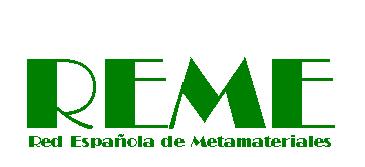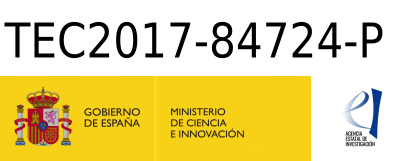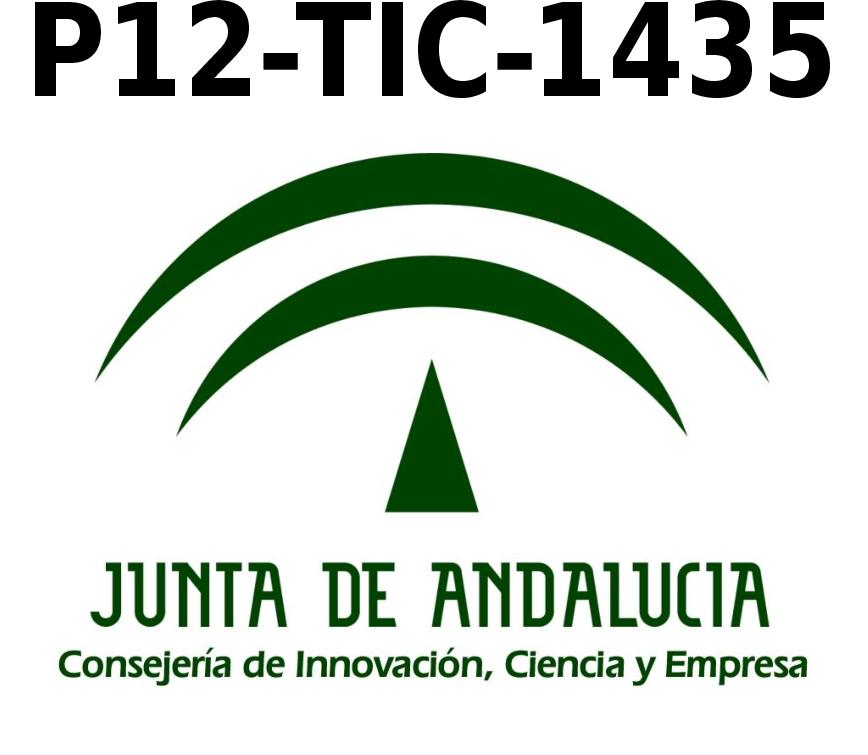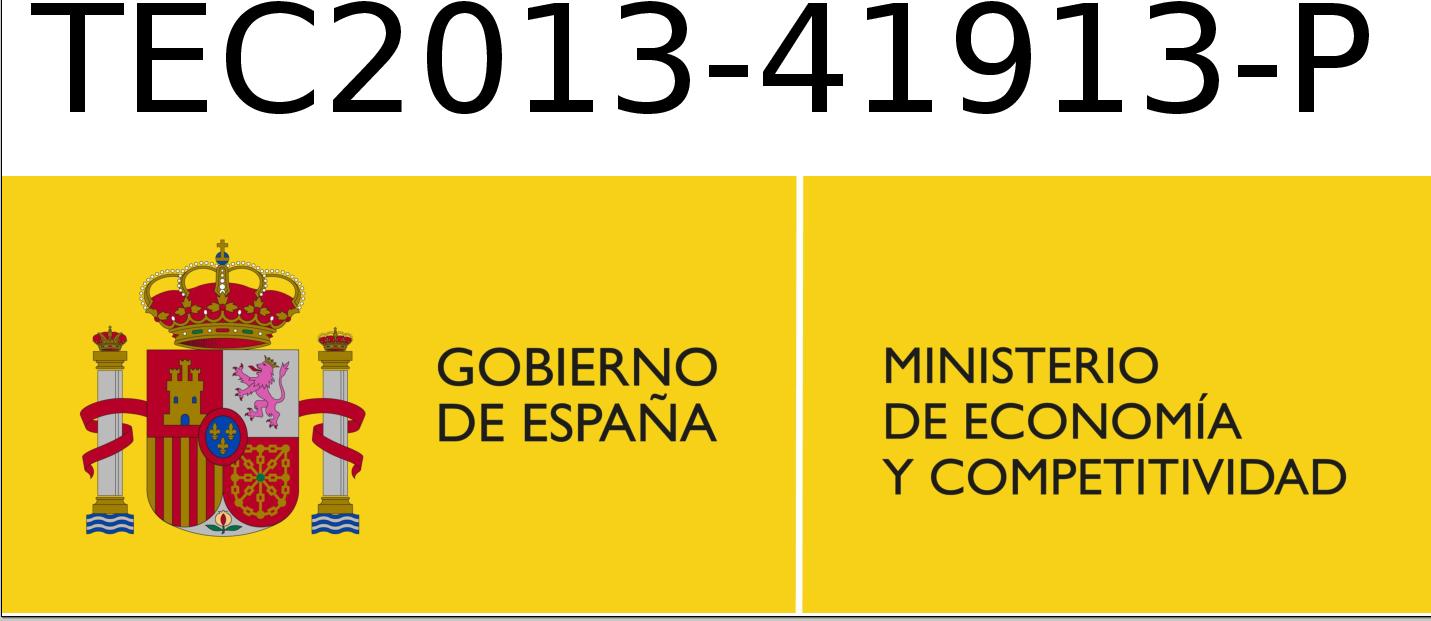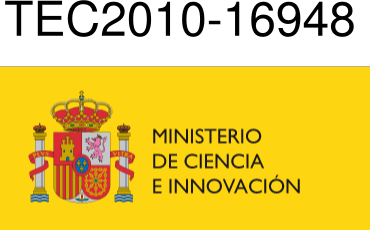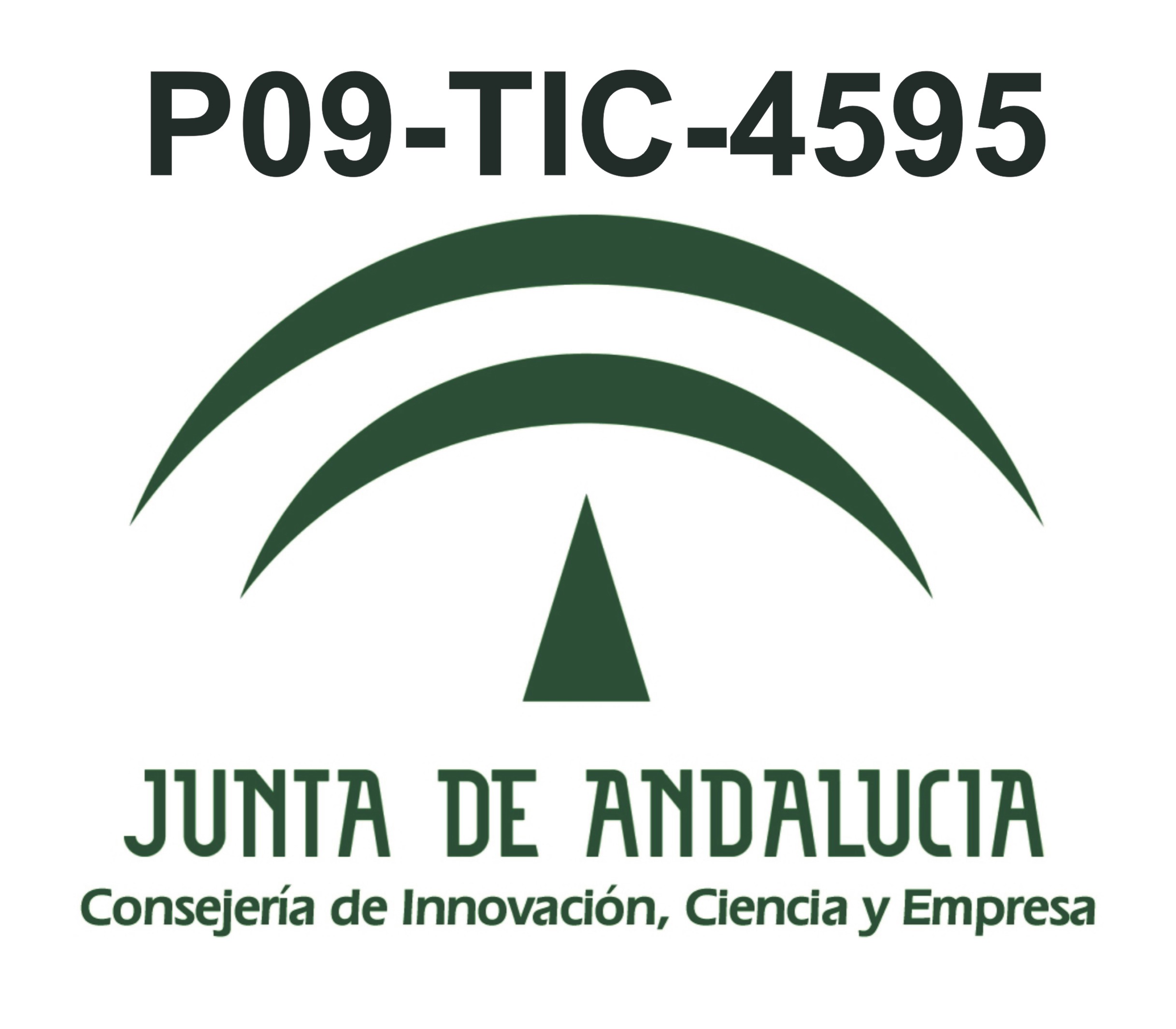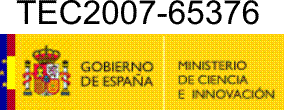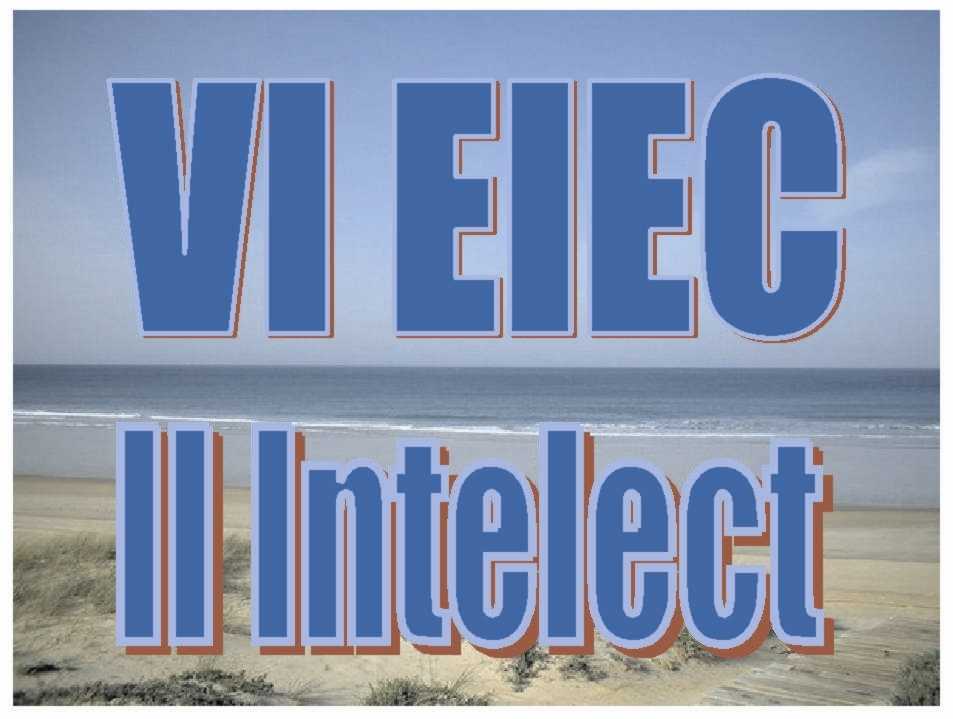Results of the project TEC2013-41913-P



3.- Results.
In this section we include those book chapters, journal papers and conference papers reporting results related to the project TEC2013-41913-P.
- JOURNAL PAPERS
- F. Mesa, M. García-Vigueras, F Medina, R. Rodríguez-Berral, J.R. Mosig,
"Circuit-model analysis of frequency selective surfaces with scatterers of arbitrary geometry,"
IEEE Antennas and Wireless Propagation Letters, 14, pp. 135-138, January 2015.
Abstract: An equivalent-network model is here proposed to characterize two-dimensional planar periodic arrays of arbitrary scatterers/apertures embedded in a layered environment. The model is an extension of the approach previously developed by some of the authors, which only considered simple rectangular scatterers. A key underlying assumption in the present approach is that the current/field distribution in the scatterer can be factorized so that the spatial profile is independent of the frequency in the considered range of interest. This approximation is proven to work properly for a great variety of useful planar scatterer/aperture patterns, even at frequencies within the diffraction regime. The spatial current/field profile is determined from a full-wave simulation at a single and low frequency value. Our numerical results are validated through comparison to commercial simulators for very wide frequency ranges as well as with previously proposed circuit-model approaches.
- A.J. Martínez-Ros, J.L. Gómez-Tornero, V. Losada, F. Mesa, F. Medina,
"Non-uniform sinusoidally modulated half-mode leaky-wave lines for near-Field focusing
pattern synthesis,"
IEEE Transactions on Antennas and Propagation, 63, no. 3, pp. 1022-1031, March 2015.
Abstract: A novel non-uniform sinusoidally modulated half-mode microstrip structure with application to near-field focused leaky-wave radiation in the backward Fresnel zone is proposed. First, it is presented a dispersion analysis of the constituent backward leaky wave in the sinusoidally modulated unit cell in half-width microstrip technology. This information is then used to design a finite non-uniform line that focuses the radiated fields at the desired point. Finally, eight similar line sources are arranged in a radial array to generate a three-dimensional focused spot located at the desired focal length over the simple central coaxial feeding. Simulated and experimental results are presented to validate the proposed simple approach.
- A. Fernández-Prieto, J. Martel, F. Medina, F. Mesa, R.R. Boix,
"Compact balanced FSIR bandpass filter modified for enhancing common-mode suppression,"
IEEE Microwave and Wireless Components Letters, 25, no. 3, pp. 154-156, March 2015.
Abstract: A novel balanced bandpass filter (BPF) based on folded stepped impedance resonators (FSIR's) with modified ground plane is presented in this work. By symmetrically introducing a series-LC resonant structure below the FSIR's, common-mode (CM) propagation can be rejected without affecting differential-mode (DM) performance. The filter presents two main advantages with respect to the conventional solid-ground-plane FSIR filter: i) an important improvement of the CM rejection level within the differential passband and ii) an enhanced filter selectivity due to the inclusion of an extra transmission zero in the differential passband. Both the conventional and the novel filters have been modeled as lumped-element circuits that fully account for DM and CM operation. Simulation and measurement results confirm the benefits of the proposed balanced BPF.
- P. Vélez, J. Naqui, A. Fernández-Prieto, J. Bonache, J. Mata-Contreras, J. Martel, F. Medina,
F. Martin,
"Ultra-compact (80 mm2) differential-mode ultra-wideband (UWB) bandpass filters with
common-mode noise suppression,"
IEEE Transactions on Microwave Theory and Techniques, 63, no. 4, pp. 1272-1280,
April 2015.
Abstract: This paper presents a novel approach for the implementation of balanced ultra-wideband (UWB) bandpass filters with common-mode noise suppression. To a first-order approximation, the differential-mode filter response is described by the canonical circuit model of a bandpass filter, i.e., a cascade of series-connected resonators alternating with shunt-connected parallel resonant tanks. Thus, the series branches of the balanced filter are implemented by means of inductive strips and patch capacitors, whereas the shunt sections are realized through mirrored stepped-impedance resonators (SIRs) and low-impedance (i.e., capacitive) short transmission-line sections. For the differential mode, the symmetry plane is a virtual ground, the wide strip sections of the SIRs are effectively grounded, and the SIRs behave as grounded inductors parallel connected to capacitors. However, for the common mode, where the symmetry plane is an open (magnetic wall), the SIRs act as shunt-connected series resonators, thus providing transmission zeros at their resonance frequencies. By properly tailoring the location of these transmission zeros, rejection of the common mode over the differential filter passband can be achieved. To illustrate the potential of the approach, an order-5 balanced bandpass filter covering the regulated band for UWB communications (3.1-10.6 GHz) is designed and fabricated. The filter exhibits common-mode rejection above 10 dB over the whole differential filter passband, with differential-mode insertion losses lower than 1.9 dB and return losses better than 10 dB. Since the proposed design approach is based on planar semi-lumped components, filter size is as small as 10.5 mm × 7.6 mm.
- R. Rodríguez-Berral, F. Mesa, F. Medina,
"Analytical multimodal network approach for 2-D arrays of planar patches/apertures embedded in a
layered medium,"
IEEE Transactions on Antennas and Propagation, 63, no. 5, pp. 1969-1984, May 2015.
Abstract: A fully analytical multimodal equivalent circuit is presented for the modeling of the scattering of an obliquely incident plane wave by a two-dimensional (2-D) periodic array of metallic patches (or apertures in a metallic screen) embedded in a layered medium. The topology of the equivalent network is rigorously derived in the analysis and all the network parameters are given in closed form. In contrast with the previously reported explicit circuit models, the proposed approach accounts for dynamical effects over a very wide frequency range, which enables the application of the model to a great variety of situations. The key advantages of the reported multimodal network representation are its analytical nature, its extremely low-computational cost and that the physical phenomena involved in the scattering can be easily understood in terms of transmission line and lumped circuital reasonings.
- A. Fernández-Prieto, A. Lujambio, J. Martel, F. Medina, F. Mesa, R. R. Boix,
"Simple and compact balanced bandpass filters based on magnetically coupled resonators,"
IEEE Transactions on Microwave Theory and Techniques, 63, no. 6, pp. 1843-1853, June
2015.
Abstract: A simple strategy is proposed to design differential-mode bandpass filters with good common-mode (CM) rejection using simple resonators. Specifically, the CM rejection is enhanced by using conventional open-loop resonators as well as folded stepped-impedance resonators without the addition of printed or lumped elements along the symmetry plane of the filter or the use of defected ground solutions. The novelty of the present proposal is that a good CM rejection is achieved by the use of magnetic coupling instead of the more commonly employed electrical coupling. Magnetic coupling inherently yields poorer CM transmission as requested by good differential filters. The resonators, due to their geometrical simplicity, can easily be cascaded to implement high-order filters. The use of simple geometries also simplifies the design methodology and makes final tuning based on electromagnetic simulation simpler or unnecessary.
- R. Florencio, R. R. Boix, J. A. Encinar,
"Fast and accurate MoM analysis of periodic arrays of multilayered stacked rectangular patches
with application to the design of reflectarray antennas,"
IEEE Transactions on Antennas and Propagation, 63, no. 6, pp. 2558-2571, June
2015.
Abstract: The scattering of plane waves by periodic arrays of stacked rectangular patches in multilayered substrates is a problem that has to be solved many times when designing reflectarray antennas made of those patches under the local periodicity assumption. The solution to the periodic multilayered problem has been traditionally carried out by means of the Galerkin's version of the method of moments (MoM) in the spectral domain. This approach involves the computation of double infinite summations, and whereas some of these summations converge very fast, some other converge very slowly. In this paper, the slowly convergent summations are computed by making use of an enhanced mixed potential integral equation (MPIE) formulation of the MoM in the spatial domain. This enhanced formulation is based on the interpolation of the multilayered periodic Green's functions, and on the efficient computation of the four-dimensional (4-D) integrals leading to the MoM matrix entries. Both the novel hybrid spectral-spatial MoM code and the standard spectral domain MoM code have been used for the design of a contoured beam reflectarray antenna. It has been verified that the spectral-spatial MoM code requires CPU times that are typically 30 times smaller than those required by the pure spectral domain MoM code.
- A. Fernández-Prieto, S. Qian, J.-S. Hong, J. Martel, F. Medina, F. Mesa, J. Naqui, F. Martín,
"Common-mode suppression for balanced bandpass filters in multilayer LCP technology,"
IET Microwaves, Optics and Antennas, 9, no. 12, pp. 1249-1253, Sept. 2015.
Abstract: A new multilayer differential transmission line for common-mode suppression fabricated using an organic liquid crystal polymer multilayer substrate is proposed and analysed. The structure consists of a pair of parallel strip lines printed on the top layer of the substrate that are capacitively coupled to conductor patches periodically etched in an intermediate interface. These patches are symmetrically connected to a solid ground plane by means of short-circuited high-impedance microstrip line sections and metalised via holes. The differential signal supported by the coupled strips is not significantly affected by the presence of the middle layer layout, whereas the common-mode signal propagation is strongly suppressed within a certain frequency band. When this structure is cascaded with a simple differential bandpass filter exhibiting poor common mode rejection, a good common mode response is achieved within the unperturbed differential passband. The measurements confirm a significant enhancement of common-mode rejection thanks to the use of the proposed differential lines.
- N. Vojnovic, B. Jokanovic, M. Radovanovic, F. Medina, F. Mesa,
"Modeling of non-resonant longitudinal and inclined slots for resonance tuning in ENZ waveguide
structures,"
IEEE Transactions on Antennas and Propagation, 63, no. 11, pp. 5107-5113, Nov.
2015.
Abstract: Novel methods are presented for the independent resonance tuning in rectangular waveguide epsilon-near-zero (ENZ) structures. This kind of tuning is achieved using short longitudinal and inclined slots placed in the middle of the ENZ channel. It is demonstrated that the tunneling frequency and Fabry-Pérot resonance (FPR) can be shifted by as much as 8 % and 9.7 %, respectively. Equivalent circuits for the tuning slots are given, and their equivalent parameters are extracted and validated. Analytical expressions for the equivalent slot reactances are also provided, and they show very good agreement with the extracted parameters. Experimental verification of both presented tuning methods is provided, and the agreement between simulated and experimental results is excellent (error less than 1 %).
- V. Torres, F. Mesa, M. Navarro-Cía, R. Rodríguez-Berral, M. Beruete, F. Medina,
"Accurate circuit modeling of fishnet structures for negative-index-medium applications,"
IEEE Transactions on Microwave Theory and Techniques, 64, no. 1, pp. 15-26, January
2016.
Abstract: Metallic plates with a two-dimensional (2D) periodic distribution of sub-wavelength apertures are known to exhibit extraordinary transmission of electromagnetic waves. Stacking two or more of such plates gives place to the so-called fishnet structures, which constitute a popular way of achieving an effective negative index medium at frequencies ranging from microwaves to optics. Unfortunately, a general wideband equivalent circuit has not yet been proposed to facilitate its understanding and design. This work presents this circuit model with closed-form expressions for the circuit elements, thus making it possible to obtain the electrical response for this class of structures in a very efficient way. This procedure is much faster than alternative numerical methods at the same time that it retains a high level of accuracy when compared with some other oversimplified models. The circuit model also provides a simple rationale as well as a good physical insight in order to explain the qualitative behavior of such structures, independently of the number of stacked layers.
- C. Molero, R. Rodríguez-Berral, F. Mesa, F. Medina, A. B. Yakovlev,
"Wideband analytical equivalent circuit for 1-D periodic stacked arrays,"
Physical Review E, 93, pp. 013306(1-14), January 2016.
Abstract: A wideband equivalent circuit is proposed for the accurate analysis of scattering from a set of stacked slit gratings illuminated by a plane wave with transverse magnetic or electric polarization that impinges normally or obliquely along one of the principal planes of the structure. The slit gratings are printed on dielectric slabs of arbitrary thickness, including the case of closely spaced gratings that interact by higher-order modes. A pi-circuit topology is obtained for a pair of coupled arrays, with fully analytical expressions for all the circuit elements. This equivalent circuit is employed as the basis to derive the equivalent circuit of finite stacks with any given number of gratings. Analytical expressions for the Brillouin diagram and the Bloch impedance are also obtained for infinite periodic stacks.
- F. Mesa, R. Rodríguez-Berral, M. Garcia-Vigueras, F. Medina, J.~R. Mosig,
"Simplified modal expansion to analyze frequency selective surfaces: equivalent circuit
approach,"
IEEE Transactions on Antennas and Propagation, 64, no. 3, pp. 1106-111,
March 2016.
Abstract: This communication extends a previously reported analytical circuit that models the plane wave scattering by 2-D arrays of planar patches/apertures embedded in a layered media. In this extension, it is assumed that the current/electric field spatial profile in the patch/aperture region can directly be taken from the eigenfields of a waveguide whose cross section matches the scatterer boundaries. This methodology exploits all the advantages of the circuit modeling and gives place to a very efficient computational tool for many practical frequency-selective surfaces (FSSs). The circuit model is expected to work up to frequencies where the isolated scatterers have their third resonance. Thus, it allows us to provide unified equivalent circuits to deal with conical incidence and with certain symmetric cases involving two or three patches/apertures in the unit cell.
- C. Molero, R. Rodríguez-Berral, F. Mesa, F. Medina,
"Dynamical equivalent circuit for 1-D periodic compound gratings,"
IEEE Transactions on Microwave Theory and Techniques, 64, no. 4, pp. 1195-1208,
April 2016.
Abstract: Metallic compound gratings are studied in this work by means of an analytical equivalent circuit approach in order to obtain its transmission and reflection properties when illuminated by a TM-polarized plane wave. A compound grating consists of the periodic repetition of a finite number of slits carved out of a thick metal slab (reflection grating) or connecting two separated open regions through groups of slits in the metal slab (transmission grating). The equivalent circuit is rigorously obtained starting from a simplified version of the integral equation for the electric field at the slits apertures. That equivalent circuit involves transmission-line sections that account for the fundamental and lowest order diffracted modes (which does give the dynamical nature to the present equivalent circuit), and lumped components to model the effect of all the higher order diffracted modes. All the relevant and complex features of the spectra can be satisfactorily explained in terms of the topology and characteristics of the equivalent circuit. In contrast with some previously reported circuit models, all the dynamical and quasi-static circuit elements are analytically and explicitly obtained in terms of the geometric and electrical parameters of the grating. The accuracy of the approximate circuit model is very good over a very wide band, as it is demonstrated by comparison with full-wave data computed with commercial electromagnetic solvers.
- C. Molero, F. Medina, R. Rodríguez-Berral, F. Mesa,
"Making metals transparent: a circuit model approach,"
Optics Express, 24, no. 9, pp. 10265-10274, May 2016.
Abstract: Solid metal films are well known to be opaque to electromagnetic waves over a wide frequency range, from low frequency to optics. High values of the conductivity at relatively low frequencies or negative values of the permittivity at the optical regime provide the macroscopic explanation for such opacity. In the microwave range, even extremely thin metal layers (much smaller than the skin depth at the operation frequency) reflect most of the impinging electromagnetic energy, thus precluding significant transmission. However, a drastic resonant narrow-band enhancement of the transparency has recently been reported. The quasi-transparent window is opened by placing the metal film between two symmetrically arranged and closely spaced copper strip gratings. This letter proposes an analytical circuit model that yields a simple explanation to this unexpected phenomenon. The proposed approach avoids the use of lengthy numerical calculations and suggests how the transmissivity can be controlled and enhanced by manipulating the values of the electrical parameters of the associated circuit model.
- M. Camacho, R.R. Boix, F. Medina,
"Computationally efficient analysis of extraordinary optical transmission through infinite
and truncated sub-wavelength hole arrays,"
Physical Review E, 93, art. 063312 (15 pp.), June 2016.
Abstract: The authors present a computationally efficient technique for the analysis of extraordinary transmission through both infinite and truncated periodic arrays of slots in perfect conductor screens of negligible thickness. An integral equation is obtained for the tangential electric field in the slots both in the infinite case and in the truncated case. The unknown functions are expressed as linear combinations of known basis functions, and the unknown weight coefficients are determined by means of Galerkin's method. The coefficients of Galerkin's matrix are obtained in the spatial domain in terms of double finite integrals containing the Greens functions (which, in the infinite case, is efficiently computed by means of Ewald's method) times cross-correlations between both the basis functions and their divergences. The computation in the spatial domain is an efficient alternative to the direct computation in the spectral domain since this latter approach involves the determination of either slowly convergent double infinite summations (infinite case) or slowly convergent double infinite integrals (truncated case). The results obtained are validated by means of commercial software, and it is found that the integral equation technique presented in this paper is at least two orders of magnitude faster than commercial software for a similar accuracy. It is also shown that the phenomena related to periodicity such as extraordinary transmission and Wood's anomaly start to appear in the truncated case for arrays with more than 100 (10 × 10) slots.
- A. Fernández-Prieto, J. Bhatker, A. Lujambio, J. Martel, F. Medina, R.R. Boix,
"Balanced bandpass filter based on magnetically coupled coplanar waveguide
folded-stepped impedance resonators,"
IET Electronics Letters, 52, no. 14, pp. 1229-1230, July 2016.
Abstract: A novel balanced differential bandpass filter implemented in coplanar waveguide (CPW) technology is presented. The filter is based on the use of two magnetically coupled CPW folded-stepped impedance resonators. The use of magnetic coupling, instead of the more common electric coupling, provides inherent common-mode rejection. Measured and simulated results demonstrate the benefits of the proposed balanced filter.
- F. Mesa, R. Rodríguez-Berral, A. Forouzmand, A. B. Yakovlev, G. W. Hanson, F. Medina,
"Excitation of discrete and continuous spectrum in sub-diffraction wire-medium type lenses,"
IEEE Transactions on Antennas and Propagation, 64, no. 12, pp. 5208-5219, Dec. 2016.
Abstract: Subwavelength imaging of the near field of a magnetic line-source excitation is studied for several wire-medium (WM) lens topologies using complex-plane analysis of the radiation integral. Nonlocal homogenization is used for the wire medium, resulting in an analytical expression for the transfer function of the lens. It is shown that by evaluating the Sommerfeld integral of the transmitted field in terms of the discrete and continuous spectra provides a general framework for better understanding of electromagnetic phenomena involved with subwavelength imaging. Results are obtained for a WM slab, and for a wire medium loaded with graphene monolayers and periodic arrays of graphene patches, demonstrating the interplay of the discrete and continuous spectral components in different operating regimes of the lenses. The imaging with a stack of silver slabs is also considered for comparison purposes.
- F. Martín, J. Naqui, A. Fernández-Prieto, P. Vélez, J. Bonache, J. Martel, F. Medina,
"The beauty of symmetry: common-mode rejection filters for high-speed interconnects and balanced
microwave circuits,"
IEEE Microwave Magazine, 18, no. 1, pp. 42-55, Jan.-Feb. 2017.
Abstract: Common-mode rejection filters operating at microwave frequencies have been the subject of intensive research activity over the last decade. These filters are of interest for the suppression of common-mode noise in high-speed digital circuits, where differential signals are widely employed due to the high immunity to noise, electromagnetic (EM) interference, and crosstalk of differential-mode interconnects. These filters can also be used to improve common-mode rejection in microwave filters and circuits dealing with differential signals. Ideally, common-mode stopband filters should be transparent for the differential mode from dc up to very high frequencies (all pass), preserve the signal integrity for such mode, and exhibit the widest and deepest possible rejection band for the common mode in the region of interest. Moreover, these characteristics should be achieved by means of structures with the smallest possible size.
- J. Martel, A. Fernández-Prieto, A. Lujambio, F. Medina, F. Mesa, R. R. Boix,
"Differential lines for common-mode suppression based in hybrid microstrip/CPW technology,"
IEEE Microwave and Wireless Components Letters, 27, no. 1, pp. 13-15, Jan. 2017.
Abstract: A symmetrical pair of differential microstrip lines implemented in hybrid microstrip/coplanar waveguide (CPW) technology is proposed. Transmission-line models are used to analyze differential- and common-mode responses, allowing efficient design with minimal optimization effort. The structure behaves as a conventional transmission line pair under differential-mode excitation, whereas asymmetrical coupled transmission line theory has to be applied to characterize common-mode operation. The common mode is strongly suppressed thanks to the introduction of a controllable transmission zero. A two-stage version of the structure is used to increase the common-mode rejection bandwidth. All the electrical parameters of the transmission lines have been obtained using an in-house fast quasi-TEM code. The good agreement between transmission-line models, full-wave simulations and measurements confirms the benefits of the structure and the design procedure.
- F. Bagci, A. Fernández-Prieto, A. Lujambio, J. Martel, J. Bernal, F. Medina,
"Compact balanced dual-band bandpass filter based on modified coupled-embedded resonators,"
IEEE Microwave and Wireless Components Letters, 27, no. 1, pp. 31-33, Jan. 2017.
Abstract: A new compact balanced dual-band bandpass filter based on coupled-embedded resonators with modified ground plane is presented in this work. Common-mode is rejected within the two differential passbands by symmetrically introducing four coupled U-shaped defected ground structures below the resonators. Common-mode rejection is significantly improved when compared with the standard (solid ground plane) filter with similar geometry thanks to the introduction of four extra transmission zeros. Due to the symmetry, the differential mode is not significantly affected by the presence of the U-shaped resonators. Circuit-model data, full-wave simulations and measurements are provided to verify the benefits of the proposed dual-band filter.
- C. Molero, R. Rodríguez-Berral, F. Mesa, F. Medina,
"Wideband analytical equivalent circuit for coupled asymmetrical non-aligned slit arrays,"
Physical Review E, 95, pp. 023303(1-12), Feb. 2017.
Abstract: Microstructured metallic devices have been extensively studied because of their interesting properties for controlling the transmission, reflection, and absorption of electromagnetic waves. A very simple implementation is an array of infinitely long parallel metal strips printed on a dielectric substrate. In the past few years, several analytical models have been reported based on the use of equivalent circuits with distributed and lumped components to account for the electrical performance of these structures. However, the proposed models are restricted to highly symmetrical configurations of the basic unit cell of the periodic structure. The purpose of this paper is to present the nontrivial extension of such circuit models to deal with nonsymmetrical structures. More specifically, a wideband equivalent-circuit model will be developed to describe the scattering properties of a pair of coupled different nonaligned slit gratings printed on a dielectric slab of arbitrary thickness. The relevant consequences of the lack of symmetry of the structures under study will be thoroughly discussed. The obtained equivalent network can be straightforwardly used to model stacked structures with an arbitrary number of nonsymmetrical striplike arrays.
- M. Camacho, A. P. Hibbins, R. Sambles, R. R. Boix, F. Medina,
"Theoretical and experimental exploration of finite sample size effects on the propagation
of surface waves supported by slot arrays,"
Physical Review B, 95, pp. 245425(1-7), June 2017.
Abstract: The propagation of surface waves supported by a finite array of slots perforated on a zero thickness perfect electrically conducting screen is studied both experimentally and theoretically. To generate numerical results, the integral equation satisfied by the electric field in the slots is efficiently solved by means of Galerkin's method, treating the metal as perfectly conducting. The finite size of the array along the direction of propagation creates a family of states of higher momentum and lower amplitude than the single mode for the corresponding infinite array. These modes are spaced in momentum with a periodicity inversely proportional to the length of the array. In addition, the finite width in the transverse direction produces a set of higher frequency modes due to this additional quantization. Both effects arising from finite sample length and width are explained by the theoretical model and validated experimentally.
- R. Florencio, R. R. Boix, J. A. Encinar, G. Toso,
"Optimized periodic MoM for the analysis and design of dual polarization multilayered
reflectarray antennas made of dipoles,"
IEEE Transactions on Antennas and Propagation, 65, no. 7, pp. 3623-3637, July 2017.
Abstract: A hybrid version of the Method of Moments (MoM) is applied to the analysis of the scattering of plane waves by periodic multilayered structures containing dipoles at two metallization levels. The MoM matrix entries involving basis functions (BFs) at different metallization levels are computed in the spectral domain as double infinite summations with fast exponential convergence. The MoM matrix entries involving BFs at the same metallization level are computed in the spatial domain as double integrals, which require low-order quadrature rules. The integrands are cross correlations between BFs times multilayered periodic Green's functions (MPGFs). The cross correlations between BFs are obtained in terms of elliptic integrals of first and second kind. Also, the MPGFs are accurately interpolated in 4-D in terms of both the spatial variables and the angles of incidence. The hybrid MoM proposed is used in the design of dual polarization reflectarray antennas under the local periodicity assumption. Thanks to the 4-D interpolation of the MPGFs, which minimizes the total number of MPGFs that have to be computed per reflectarray element, the proposed hybrid MoM is shown to be around 15 times faster than the standard spectral domain MoM in the design of the antennas.
- F. Bagci, F. Medina,
"Design of a wide-angle, polarization insensitive, dual-band, metamaterial absorber
with the aid of equivalent circuit model,"
Journal of Computational Electronics, 16, no. 3, pp. 913-921, September 2017.
Abstract: We present the design of a wide-angle, polarization-insensitive, dual-band, low-profile metamaterial-inspired absorber for operation at two wireless local area network channels, related to 2.45 and 5 GHz industrial, scientific and medical frequencies. The design synthesis methodology involves equivalent circuit model calculations with the use of analytical expressions of capacitive and inductive elements prior to full-wave electromagnetic optimization, for easily acquiring of very high absorption conditions at the targeted frequencies. The unit cell of the metamaterial-inspired absorber consists of a joint metallic Jerusalem cross resonator with interdigital capacitors and a tetra-arrow resonator printed on top of a grounded 1-mm-thick lossy FR-4 substrate. The proposed absorber shows almost unity absorptivity at the targeted frequencies and a robust absorption characteristic under changes in incidence angle and polarization. The proposed structure can be used for protection of the systems from electromagnetic interference with existing wireless local area network frequencies.
- C. Molero, M. García-Vigueras, R. Rodríguez-Berral, F. Mesa, N. Llombart,
"Equivalent circuit approach for practical applications of meander-line gratings,"
IEEE Antennas and Wireless Propagation Letters, vol. 16, pp. 3088-3091, October 2017.
Abstract: This letter reports an analytical circuit model to characterize periodic arrangements of printed meander lines. The methodology employed for the derivation of the model is presented together with two typical examples of its possible application: a polarizer and an absorber. Comparisons with results provided by a commercial software evidence the good accuracy provided by the equivalent circuit.
- F. Aznar-Ballesta, J. Selga , P. Vélez, A. Fernández-Prieto, J. Coromina, J. Bonache, F.
Martín,
"Slow-wave coplanar waveguides based on inductive and capacitive loading and application to
compact and harmonic suppressed power splitters,"
International Journal of Microwave and Wireless Technologies, doi:10.1017/S1759078717001350, pp.
1-8, December 2017.
Abstract: In this paper, a slow-wave transmission line implemented in coplanar waveguide technology, based on simultaneous inductive and capacitive loading, is presented for the first time. The shunt capacitors are achieved by periodically etching transverse strips in the back substrate side, connected to the central strip through metallic vias. The series inductors are implemented by etching rectangular slots in the ground plane. The effect of these reactive elements is an enhancement of the effective shunt capacitance and series inductance of the line, leading to a significant reduction of the phase velocity (slow-wave effect). Consequently, the guided wavelength is also reduced, and these lines can be applied to the miniaturization of microwave components. Moreover, due to periodicity, these artificial lines exhibit stop bands (Bragg effect) useful for spurious or harmonic suppression. A compact harmonic suppressed power splitter, based on a slow wave 35.35 V impedance inverter, has been designed and fabricated in order to demonstrate the potential of the proposed approach. The length of the inverter is 48 % the length of the conventional counterpart, and measured power splitting at the first (3 f0 ) and second (5 f0) harmonic frequencies is rejected more than 49 and 23 dB, respectively.
- P. Rodríguez-Ulibarri, M. Navarro-Cía, R. Rodríguez-Berral, F. Mesa, F. Medina, M. Beruete,
"Annular apertures in metallic screens as extraordinary transmission and frequency selective
surface structures,"
IEEE Transactions on Microwave Theory and Techniques, vol. 65, no. 12, pp. 4933-4946, December
2017.
Abstract: A two dimensional periodic array of annular apertures (or ring slots) is studied using an accurate circuit model. The model accounts for distributed and dynamic effects associated with the excitation of high-order modes operating above or below cut-off but not far from their cut-off frequencies. This study allows to ascertain the substantial differences of the underlying physics when this structure operates as a classical frequency selective surface or in the extraordinary-transmission regime. A discussion of two different designs working at each regime is provided by means of the equivalent circuit approach, full wave simulation results, and experimental characterization. The agreement between the equivalent circuit calculation applied here and the simulation and experimental results is very good in all the considered cases. This validates the equivalent circuit approach as an efficient minimal-order model and a low computational-cost design tool for frequency selective surfaces and extraordinary transmission based devices. Additional scenarios such as oblique incidence and parametric studies of the structural geometry are also considered.
- F. Mesa, R. Rodríguez-Berral, F. Medina,
"Unlocking complexity using the ECA: the Equivalent Circuit Model as an efficient and
physically insightful tool for microwave engineering,"
IEEE Microwave Magazine, vol. 19, no. 4, pp. 44-65, June 2018.
Abstract: In the study of the propagation and scattering of electromagnetic waves, researchers have always faced the dichotomy of dealing directly with Maxwell's equations and their complicated analytical/numerical methods of solution or trying to find some simplified model (usually in terms of an equivalent circuit) that can help to provide some physical insight into the involved electromagnetic phenomena. The pursuit of analytical solutions for propagation, radiation, and scattering problems in Microwave Engineering does not seem to be a very demanded task nowadays, although it was only twenty years ago that many research papers on these topics used to include some sort of analytic derivations. The impressive progress of computer hardware as well as Computational Electromagnetic has made that most electromagnetic problems, either simple or very complex, currently solvable by means of commercial simulators. This trend has the advantage of enabling the analysis of many different complex electromagnetic scenarios by means of computational resources affordable to most research laboratories. However, it has also brought up the unfortunate loss of some fruitful skills, among them the ability to find out appropriate minimal-order models of complex electromagnetic problems whose relevant parameters can be obtained in closed form. A particular type of problems that was found to be very adequate to exploit the advantages of a minimal-order model approach was the scattering of electromagnetic waves by discontinuities in waveguiding systems.
Go up
- F. Mesa, M. García-Vigueras, F Medina, R. Rodríguez-Berral, J.R. Mosig,
"Circuit-model analysis of frequency selective surfaces with scatterers of arbitrary geometry,"
IEEE Antennas and Wireless Propagation Letters, 14, pp. 135-138, January 2015.
- INTERNATIONAL CONFERENCE PAPERS/ABSTRACTS
-
R. Florencio, R. R. Boix, J. A. Encinar,
"Improvements in the MoM Analysis of 3-D planar multilayered periodic structures used in the
design of wideband reflectarray antennas,"
The 9th European Conference on Antennas and Propagation, EuCAP 2015, (Lisbon, Portugal),
12-17 Abril 2015, (5 pages in ISBN: 9781479970513).
-
C. Molero, R. Rodríguez-Berral, F. Mesa, F. Medina,
"Wideband equivalent circuit for 1-D periodic compound gratings,"
The 9th European Conference on Antennas and Propagation, EuCAP 2015, (Lisbon, Portugal),
12-17 April 2015. (3 pages in IEEE Xplore ISBN: 978-8-8907-0186-3).
-
R. Florencio, R.R. Boix, J.A. Encinar,
"Recent computational and technological advances in the analysis and design of reflectarray
antennas,"
X Iberian Meeting on Computational Electromagnetics, EIEC 2015, (Baeza, Spain), pp. E1-1 to
E1-4, 5-8 May 2015 (ISBN-13: 978-84-606-7720-8).
-
A. Fernández-Prieto, J. Martel, F. Medina, F. Mesa, R.R. Boix, J. Naqui, P. Vélez, F. Martín,
"Recent contributions on common-mode bandstop and differential mode bandpass filtering,"
X Iberian Meeting on Computational Electromagnetics, EIEC 2015, (Baeza, Spain), pp.
E2-1 to E2-4, 5-8 May 2015 (ISBN-13: 978-84-606-7720-8).
-
R. Rodríguez-Berral, F. Mesa, C. Molero, F. Medina,
"Enhanced analytical models for periodic electromagnetic structures,"
X Iberian Meeting on Computational Electromagnetics, EIEC 2015, (Baeza, Spain), pp. E3-1 to
E3-2, 5-8 May 2015 (ISBN-13: 978-84-606-7720-8).
-
R. Rodríguez-Berral, F. Mesa, F. Medina,
"Circuit model for FSS structures under conical oblique incidence,"
1st URSI Atlantic Radio Science Conference, AT-RASC-URSI 2015, (Gran Canaria, Spain), 18-22
Mayo 2015 (abstract), (ISBN: 9789090086286).
-
V. Torres, F. Mesa, M. Navarro-Cía, R. Rodr&icuate;guez-Berral, M. Beruete, F. Medina,
"Analytical model for fishnet structures: a systematic circuit approach,"
The 9th International Congress on Advanced Electromagnetic Materials in Microwaves
and Optics, Metamaterials 2015, (Oxford, UK), 7-10 September 2015, pp. 916-918 (ISBN:
978-88-941141-0-2). (invited paper).
-
C. Molero, F. Medina, R. Rodríguez-Berral, F. Mesa,
"Making metals transparent: a circuit model approach,"
The 9th International Congress on Advanced Electromagnetic Materials in Microwaves
and Optics, Metamaterials 2015, (Oxford, UK), 7-10 September 2015, pp. 928-930 (ISBN:
978-88-941141-0-2).
-
C. Molero, F. Medina, R. Rodríguez-Berral, F. Mesa,
"Metal grating with slits and grooves for transmission control: an analytical approach,"
The 9th International Congress on Advanced Electromagnetic Materials in Microwaves
and Optics, Metamaterials 2015, (Oxford, UK), 7-10 September 2015, pp. 132-134 (ISBN:
978-88-941141-0-2). Poster.
-
C. Molero, R. Rodríguez-Berral, F. Mesa, F. Medina,
"Wideband equivalent circuit for non-aligned 1-D periodic metal strips coupled gratings,"
45th European Microwave Conference, EuMC 2015, (Paris, France), 6-10 septiembre 2015, pp.
331-334, (ISBN: 978-2-87487-039-2). Mr. Carlos Molero received the Young Engineer Prize.
-
F. Medina, J.-S. Hong,
"Symmetric artificial transmission lines for common-mode bandstop and differential-mode bandpass
filtering," oral session, workshop WM02 at
45th European Microwave Conference, EuMC 2015 . (Paris, France), 6th of September 2015. -
F. Medina, F. Mesa, R. Rodríguez-Berral, C. Molero,
"Circuit modeling of periodic structures,"
(invited talk), The Exeter Microwaves Metamaterials Meeting XM2. (Exeter, UK), 7-8
December 2015.
-
C. Molero, R. Rodríguez-Berral, F. Mesa, F. Medina,
"Study of the electromagnetic response of some periodic structures via equivalent circuits,"
(poster), The Exeter Microwaves Metamaterials Meeting XM2, (Exeter, UK), 7-8
December 2015.
-
M. García-Vigueras, F. Mesa, R. Rodríguez-Berral, F. Medina, J. R. Mosig,
"Pseudo-analytical circuits for dual-polarized FSS,"
The 10th European Conference on Antennas and Propagation, EuCAP 2016, (Davos, Switzerland),
10-15 April 2016 (IEEE Xplore ISBN: 978-88-907018-6-3, 4 pages, DOI: 10.1109/EuCAP.2016.7481372).
-
F. Mesa, A. Forouzmand, A. B. Yakovlev, G. W. Hanson, F. Medina, R. Rodriguez-Berral,
"Discrete and continuous spectrum in subwavelength imaging with wire-medium type lenses,"
2016 IEEE-TAP Antennas and Propagation Symposium, APS-URSI 2016, (Fajardo, Puerto
Rico), paper MO-UB.1A.1, 26 junio - 1 de julio 2016.
-
F. Medina, C. Molero, R. Rodríguez-Berral, F. Mesa,
"Accurate circuit models for the analysis of stacked metal gratings,"
16th International Conference on Mathematical Methods in Electromagnetic
Theory, MMET 2016, (Lviv, Ucrania), pp. 39-42, 5-7 July 2016 (IEEE Xplore, DOI:
10.1109/MMET.2016.7544087, ISBN: 978-1-5090-1956-4/16/, Electronic ISSN: 2161-1750). (invited,
plenary session).
-
F. Mesa, R. Rodríguez-Berral, M. García-Vigueras, F. Medina, J. R. Mosig,
"Equivalent admittance approach for the scattering of patch/slot-based frequency selective
surfaces,"
IEEE MTT-S International Conference on Numerical Electromagnetic and Multiphysics
Modeling and Optimization, NEMO 2016, (Beijing, China), 27-29 July 2016. (IEEE Xplore ISBN:
978-1-4673-8762-0/16/, DOI: 10.1109/NEMO.2016.7561580, 2 pages).
-
F. Mesa, A. Forouzmand, A.~B. Yakovlev, G.~W. Hanson, F. Medina, R. Rodríguez-Berral,
"Discrete and continuous spectrum analysis: an alternative perspective on subwavelength
imaging,"
The 10th International Congress on Advanced Electromagnetic Materials in
Microwaves and Optics, Metamaterials 2016, (Crete, Greece), pp. 799-801, 19-22 September
2016. (ISBN: 978-88-941141-1-9).
-
F. Bagci, F. Medina,
"Design of a dual band metamaterial absorber in WLAN bands with high stability over incidence
angle and polarization,"
The 10th International Congress on Advanced Electromagnetic Materials in
Microwaves and Optics, Metamaterials 2016, (Crete, Greece), pp. 668-670, 19-22
September 2016. (ISBN: 978-88-941141-1-9).
-
C. Molero, R. Rodríguez-Berral, F. Mesa, F. Medina,
"Analytical modeling of non-symmetric and non-uniform compound gratings,"
46th European Microwave Conference, EuMC 2016, (London, UK), pp. 100-103
4-6 octubre 2016. (ISBN: 978-2-87487-043-9).
-
F. Medina, F. Mesa, R. Rodríguez-Berral, R. R. Boix,
"Analytical and highly efficient numerical modeling of electromagnetic periodic structures,"
2016 IEEE MTT-S Latin America Microwave Conference (LAMC-2016), (Puerto
Vallarta, México), paper 127, 12-14 diciembre 2016. (ISBN: 978-1-5090-4287-6/16/).
-
R. Florencio, R. R. Boix, J. A. Encinar,
"Improvements in the MoM Analysis of 3-D planar multilayered periodic structures used in the
design of wideband reflectarray antennas,"
The 9th European Conference on Antennas and Propagation, EuCAP 2015, (Lisbon, Portugal),
12-17 Abril 2015, (5 pages in ISBN: 9781479970513).
- NATIONAL CONFERENCE PAPERS/ABSTRACTS
-
A. Fernández-Prieto, A. Lujambio, J. Martel, F. Medina, F. Mesa, R.R. Boix,
"Diseño de un filtro diferencial con supresión del modo común basado en resonadores
acoplados magnéticamente,"
XXX Symposium Nacional de URSI (Pamplona, Navarra), 2-4 September 2015. (4 pages in CD-ROM).
-
F. Medina, F. Mesa, R. Rodríguez-Berral, C. Molero,
"Circuitos equivalentes para estructuras periódicas y metamateriales,"
XXX Symposium Nacional de URSI (Pamplona, Navarra), 2-4 September 2015. (4 pages in CD-ROM).
(invited contribution).
-
F. Mesa, R. Rodríguez-Berral, F. Medina, C. Molero,
"Consideraciones sobre las limitaciones de los circuitos equivalentes para el análisis del
scattering por estructuras periódicas,"
XXX Symposium Nacional de URSI (Pamplona, Navarra), 2-4 September 2015. (4 pages in CD-ROM).
(invited contribution).
-
F. Bagci, A. Fernández-Prieto, A. Lujambio, J. Martel, J. Bernal, F. Medina,
"Filtro balanceado compacto con doble banda de paso basado en resonadores
embebidos modificados,"
XXXI Symposium Nacional de URSI, Actas del congreso (4 páginas, ISBN:
978-84-608-9674-6), Madrid, 5-7 septiembre 2016.
-
C. Molero, R. Rodríguez Berral, F. Mesa, F. Medina,
"Modelo circuital para rejillas de difracción acopladas no alineadas,"
XXXI Symposium Nacional de URSI, Actas del congreso (4 páginas, ISBN:
978-84-608-9674-6), Madrid, 5-7 septiembre 2016.
-
C. Molero, R. Rodríguez Berral, F. Mesa, F. Medina,
"Modelo de circuito para rejillas de difracción compuestas con ranuras no uniformes,"
XXXI Symposium Nacional de URSI, Actas del congreso (4 páginas, ISBN:
978-84-608-9674-6), Madrid, 5-7 septiembre 2016.
-
A. Berenguer, A. Coves, F. Mesa, E. Bronchalo, B. Gimeno, V. Boria,
"Analysis of the electrostratic field generated by a charge distribution on a dielectric layer
loading a rectangular waveguide,"
XXXI Symposium Nacional de URSI, Actas del congreso (4 páginas, ISBN:
978-84-608-9674-6), Madrid, 5-7 septiembre 2016.
-
A. Fernández-Prieto, A. Lujambio, J. Martel, F. Medina, F. Mesa, R.R. Boix,
"Diseño de un filtro diferencial con supresión del modo común basado en resonadores
acoplados magnéticamente,"
XXX Symposium Nacional de URSI (Pamplona, Navarra), 2-4 September 2015. (4 pages in CD-ROM).

